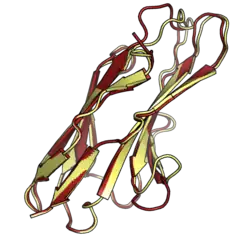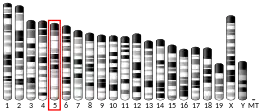PILRB
Paired immunoglobulin-like type 2 receptor beta is a protein that in humans is encoded by the PILRB gene.[5][6]
| PILRB | |||||||||||||||||||||||||||||||||||||||||||||||||||
|---|---|---|---|---|---|---|---|---|---|---|---|---|---|---|---|---|---|---|---|---|---|---|---|---|---|---|---|---|---|---|---|---|---|---|---|---|---|---|---|---|---|---|---|---|---|---|---|---|---|---|---|
 | |||||||||||||||||||||||||||||||||||||||||||||||||||
| |||||||||||||||||||||||||||||||||||||||||||||||||||
| Identifiers | |||||||||||||||||||||||||||||||||||||||||||||||||||
| Aliases | PILRB, FDFACT1, FDFACT2, paired immunoglobin-like type 2 receptor beta, paired immunoglobin like type 2 receptor beta | ||||||||||||||||||||||||||||||||||||||||||||||||||
| External IDs | OMIM: 605342 MGI: 2450532 HomoloGene: 114502 GeneCards: PILRB | ||||||||||||||||||||||||||||||||||||||||||||||||||
| |||||||||||||||||||||||||||||||||||||||||||||||||||
| |||||||||||||||||||||||||||||||||||||||||||||||||||
| |||||||||||||||||||||||||||||||||||||||||||||||||||
| |||||||||||||||||||||||||||||||||||||||||||||||||||
| |||||||||||||||||||||||||||||||||||||||||||||||||||
| Wikidata | |||||||||||||||||||||||||||||||||||||||||||||||||||
| |||||||||||||||||||||||||||||||||||||||||||||||||||
Function
Cell signaling pathways rely on a dynamic interaction between activating and inhibiting processes. SHP-1-mediated dephosphorylation of protein tyrosine residues is central to the regulation of several cell signaling pathways. Two types of inhibitory receptor superfamily members are immunoreceptor tyrosine-based inhibitory motif (ITIM)-bearing receptors and their non-ITIM-bearing, activating counterparts.
Control of cell signaling via SHP-1 is thought to occur through a balance between PILRalpha-mediated inhibition and PILRbeta-mediated activation. These paired immunoglobulin-like receptor genes are located in a tandem head-to-tail orientation on chromosome 7. This particular gene encodes the non-ITIM-bearing member of the receptor pair, which has a truncated cytoplasmic tail relative to its ITIM-bearing partner and functions in the activating role. Alternative splicing has been observed at this locus and three variants, encoding two distinct isoforms, are described. Additional transcript variants have been identified but their full-length nature has not been determined.[6]
The mouse homolog of PILRbeta has been studied in mice and found to have one known natural ligand, CD99, though it is unclear if this interaction occurs in the human homologs.[7]
Structure
As with other paired receptors, PILRbeta has a truncated cytoplasmic tail compared to PILRalpha and features a charged residue within its transmembrane domain.[8][9] PILRbeta has an extracellular domain with a siglec-like immunoglobulin fold that substitutes hydrophobic interactions for the siglec fold's characteristic disulfide bond. The structure of this domain is very similar to that of PILRalpha, but the two proteins nevertheless have different binding affinities for sialic acid.[7]
References
- GRCh38: Ensembl release 89: ENSG00000121716 - Ensembl, May 2017
- GRCm38: Ensembl release 89: ENSMUSG00000066684 - Ensembl, May 2017
- "Human PubMed Reference:". National Center for Biotechnology Information, U.S. National Library of Medicine.
- "Mouse PubMed Reference:". National Center for Biotechnology Information, U.S. National Library of Medicine.
- Mousseau DD, Banville D, L'Abbé D, Bouchard P, Shen SH (February 2000). "PILRalpha, a novel immunoreceptor tyrosine-based inhibitory motif-bearing protein, recruits SHP-1 upon tyrosine phosphorylation and is paired with the truncated counterpart PILRbeta". The Journal of Biological Chemistry. 275 (6): 4467–74. doi:10.1074/jbc.275.6.4467. PMID 10660620.
- "Entrez Gene: PILRB paired immunoglobin-like type 2 receptor beta".
- Lu Q, Lu G, Qi J, Wang H, Xuan Y, Wang Q, et al. (June 2014). "PILRα and PILRβ have a siglec fold and provide the basis of binding to sialic acid". Proceedings of the National Academy of Sciences of the United States of America. 111 (22): 8221–6. Bibcode:2014PNAS..111.8221L. doi:10.1073/pnas.1320716111. PMC 4050567. PMID 24843130.
- Mousseau DD, Banville D, L'Abbé D, Bouchard P, Shen SH (February 2000). "PILRalpha, a novel immunoreceptor tyrosine-based inhibitory motif-bearing protein, recruits SHP-1 upon tyrosine phosphorylation and is paired with the truncated counterpart PILRbeta". The Journal of Biological Chemistry. 275 (6): 4467–74. doi:10.1074/jbc.275.6.4467. PMID 10660620.
- Wilson MD, Cheung J, Martindale DW, Scherer SW, Koop BF (November 2006). "Comparative analysis of the paired immunoglobulin-like receptor (PILR) locus in six mammalian genomes: duplication, conversion, and the birth of new genes". Physiological Genomics. 27 (3): 201–18. doi:10.1152/physiolgenomics.00284.2005. PMID 16926269.




